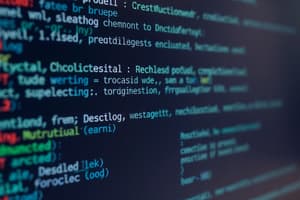Podcast
Questions and Answers
What is the process of putting a message into an addressed envelope called?
What is the process of putting a message into an addressed envelope called?
- Formatting
- Transmission
- Encapsulation (correct)
- Decoding
Each frame sent over the network does not require its own addressing information.
Each frame sent over the network does not require its own addressing information.
False (B)
What are the three types of message delivery options?
What are the three types of message delivery options?
Unicast, Multicast, Broadcast
Messages must be broken into smaller pieces to travel across a network, and each piece is sent in a separate ______.
Messages must be broken into smaller pieces to travel across a network, and each piece is sent in a separate ______.
What is the purpose of flow control in networking?
What is the purpose of flow control in networking?
The destination host does not need to decode the signals to interpret the message.
The destination host does not need to decode the signals to interpret the message.
What must hosts on a network know to avoid collisions during message transmission?
What must hosts on a network know to avoid collisions during message transmission?
Match the following types of message delivery to their definitions:
Match the following types of message delivery to their definitions:
Which of the following are common networking protocols? (Select all that apply)
Which of the following are common networking protocols? (Select all that apply)
The Ethernet protocol works at the application layer.
The Ethernet protocol works at the application layer.
What is the role of TCP in the protocol interaction between a web server and client?
What is the role of TCP in the protocol interaction between a web server and client?
The process of adding the IP source and destination addresses creates an _____ packet.
The process of adding the IP source and destination addresses creates an _____ packet.
What is the first step in the TCP/IP communication process when sending data from a web server?
What is the first step in the TCP/IP communication process when sending data from a web server?
A web client and web server communicate using only a single protocol.
A web client and web server communicate using only a single protocol.
Identify one major function of the Ethernet protocol.
Identify one major function of the Ethernet protocol.
Match the following protocols with their primary functions:
Match the following protocols with their primary functions:
What is the correct order in which protocol headers are removed from data link frames at the client?
What is the correct order in which protocol headers are removed from data link frames at the client?
Open standards are intended to limit competition in technology fields.
Open standards are intended to limit competition in technology fields.
Name one organization responsible for managing IP address allocation.
Name one organization responsible for managing IP address allocation.
The ____ Task Force focuses on long-term research related to Internet and TCP/IP protocols.
The ____ Task Force focuses on long-term research related to Internet and TCP/IP protocols.
Match the following organizations with their primary functions:
Match the following organizations with their primary functions:
Which of the following organizations is NOT focused on Internet standards?
Which of the following organizations is NOT focused on Internet standards?
The Telecommunications Industry Association (TIA) develops standards primarily for wired networks only.
The Telecommunications Industry Association (TIA) develops standards primarily for wired networks only.
Which organization manages domain name management?
Which organization manages domain name management?
Which layer of the OSI model is responsible for process-to-process communications?
Which layer of the OSI model is responsible for process-to-process communications?
The TCP/IP model was created in the early 1980s.
The TCP/IP model was created in the early 1980s.
What is the primary benefit of using a layered model?
What is the primary benefit of using a layered model?
The ______ layer provides services to the presentation layer to manage data exchange.
The ______ layer provides services to the presentation layer to manage data exchange.
Match the following layers with their functions:
Match the following layers with their functions:
What is one benefit of using a layered model in networking?
What is one benefit of using a layered model in networking?
The OSI model and the TCP/IP model have the same number of layers.
The OSI model and the TCP/IP model have the same number of layers.
What does the Data Link layer provide?
What does the Data Link layer provide?
What is the primary purpose of message segmentation in data transfer?
What is the primary purpose of message segmentation in data transfer?
The de-encapsulation process occurs from bottom to top.
The de-encapsulation process occurs from bottom to top.
What does PDU stand for?
What does PDU stand for?
At the Physical Layer, the PDU is referred to as ______.
At the Physical Layer, the PDU is referred to as ______.
Which layer's PDU is referred to as a 'Segment'?
Which layer's PDU is referred to as a 'Segment'?
Match the following protocol layers with their corresponding PDUs:
Match the following protocol layers with their corresponding PDUs:
Only the entire message needs to be retransmitted if part of it fails to arrive at the destination.
Only the entire message needs to be retransmitted if part of it fails to arrive at the destination.
What are the source and destination addresses responsible for in the network layer?
What are the source and destination addresses responsible for in the network layer?
Flashcards are hidden until you start studying
Study Notes
Message Encoding
- Messages between hosts must be in a format appropriate for the transmission medium.
- Sending hosts convert messages into bits.
- Each bit is encoded as sound, light waves, or electrical impulses depending on the network.
- Receiving hosts decode the signals to interpret the message.
Message Formatting and Encapsulation
- There is an agreed format for messages, required for proper delivery.
- Encapsulation is the process of putting the message into a frame.
- A frame acts like an envelope, providing source and destination addresses.
Message Size
- Long messages are broken into smaller pieces to travel across the network.
- Each piece is sent in a separate frame with its own addressing information.
- The receiving host reassembles the frames into the original message.
Message Timing
- Hosts must know when to send messages and how to handle collisions.
- Flow control helps negotiate correct timing to avoid overwhelming the destination.
- Response timeout rules specify how long to wait for responses and what action to take if there's no response.
Message Delivery Options
- Unicast: One-to-one delivery
- Multicast: One-to-many delivery
- Broadcast: One-to-all delivery
Protocols
- Protocols define a common format for exchanging messages between devices.
- Protocol suites are implemented in devices using hardware and software.
- Protocols are viewed in terms of layers, with higher levels depending on lower levels.
Network Protocols
- Common networking protocols include HTTP, TCP, and IP.
Protocol Interaction
- Communication between a web server and web client involves multiple protocols:
- HTTP: Governs the interaction between web server and client
- TCP: Manages individual conversations
- IP: Encapsulates TCP segments into packets, assigns addresses, and delivers to the destination.
- Ethernet: Allows communication over a data link and physical transmission of data.
TCP/IP Protocol Suite
- TCP/IP is a widely used protocol suite for internet communication.
TCP/IP Communication Process
- When sending data from a web server to a client:
- The data is prepared.
- The HTTP application layer sends it to the transport layer.
- The transport layer breaks the data into segments.
- The IP layer adds source and destination addresses, forming an IP packet.
- The Ethernet information is added, creating the Ethernet frame.
- When receiving data:
- The client removes each protocol header in reverse order.
- The data is finally processed and sent to the client's web browser.
Standards Organizations
- Standards organizations promote interoperability, competition, and innovation.
- They are vendor-neutral and non-profit.
Internet Standards
- ISOC: Promotes open development and evolution of Internet use globally.
- ICANN: Coordinates IP address allocation and domain name management.
- IAB: Manages and develops Internet standards.
- IANA: Manages IP address allocation, domain name management, and protocol identifiers for ICANN.
- IETF: Develops, updates, and maintains Internet and TCP/IP technologies.
- IRTF: Focuses on long-term research related to Internet and TCP/IP.
Electronics and Communications Standard Organizations
- IEEE: Advances technological innovation and creates standards in various industries, including networking.
- EIA: Creates standards related to electrical wiring, connectors, and network racks.
- TIA: Creates standards for radio equipment, cellular towers, VoIP devices, and satellite communications.
- ITU-T: Creates standards for video compression, IPTV, and broadband communications.
Reference Models
- Layered models assist in protocol design, foster competition, prevent technology changes from affecting other layers, and provide a common language for networking.
The OSI Reference Model
- Application: Contains protocols for process-to-process communication.
- Presentation: Provides common representation of data.
- Session: Manages data exchange and dialogue.
- Transport: Segments, transfers, and reassembles data.
- Network: Exchanges individual pieces of data between identified devices.
- Data Link: Exchanges data frames between devices over a common media.
- Physical: Describes the physical means of transmitting bits.
The TCP/IP Protocol Model
- Created in the early 1970s for internet communication.
- An open standard.
- Also called the TCP/IP Model or the Internet Model.
OSI Model and TCP/IP Model Comparison
- The OSI model further divides the network access and application layer of the TCP/IP model.
Data Encapsulation
- Large streams of data are divided into smaller pieces for efficient network transmission.
- Each piece is labeled to allow retransmission of missing parts.
- This process is called multiplexing, allowing interleaving of multiple conversations.
Protocol Data Units
- Each layer adds information to the data during encapsulation.
- This forms a Protocol Data Unit (PDU).
- Data: Application layer PDU
- Segment: Transport layer PDU
- Packet: Network layer PDU
- Frame: Data Link Layer PDU
- Bits: Physical Layer PDU
Encapsulation Example
- The encapsulation process works from top to bottom:
- Data is divided into segments.
- The TCP segment is encapsulated in the IP packet.
- The IP packet is encapsulated in the Ethernet frame.
De-encapsulation
- De-encapsulation is the process of removing protocol headers from data moving up the stack.
Data Access
- Network layer addresses support IP packet delivery from the source to the final destination.
- Source IP address: The IP address of the sending device.
- Destination IP address: The IP address of the receiving device.
Data Link Addresses
- Data link addresses support frame delivery from one network interface to another on the same network.
Studying That Suits You
Use AI to generate personalized quizzes and flashcards to suit your learning preferences.




